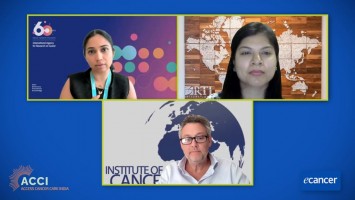As you know, cervical cancer is one of the highest burden of cervical cancer as well as mortalities in India. So we’ve gathered here to formulate our policies, both for treatment, screening, vaccination.
Do you think the recently published ASCO guidelines will be applicable to India?
I think they are unlikely to be even applicable to low and middle income countries the way they have been formulated because what they have given in basic and limited criteria, it is a mockery of treatment of patients with cervical cancer because in a limited setting they talk of giving neoadjuvant chemotherapy. The complications of neoadjuvant chemotherapy can be enormous, how would you manage them within a limited resource? Then they talk of doing hysterectomy after external radiation rather than brachytherapy – now how many surgeons would be trained in limited settings to do a hysterectomy after a patient has received radiation? So there’s likelihood that more people will end up receiving even further sub-optimal treatment with the guidelines that have been recommended by ASCO. At the National Cancer Grid we have reviewed our patterns of practice within our country, there have been drafts that have got circulated, and we agree, a consensus has been made, that we should treat cervical cancer in a very standard way if we need optimal outcomes, not in the way that ASCO has recommended for basic and limited settings. Can you believe ASCO has recommended palliative care for stage 3b? In stage 3b the outcomes at our institution are 85% local control at three years, 55% disease free survival at five years, and they want to clap it to palliative care? I don’t think I agree with those guidelines and most of my colleagues would probably share the same sentiments.
Are the National Cancer Grid guidelines ready to be presented?
I would say they are 95% ready; the first draft has been finalised. So we have this National Cancer Grid of 64 institutions within India, the draft was circulated to a core committee that was identified, a list of experts. So they have come with around 20-21 odd recommendations which we have discussed today and it’s likelihood that a brief final ready ready draft is ready within a month’s time.
How is vaccination used to prevent cervical cancer in India?
In India HPV vaccination is not part of the national programme. A few states are looking into it but it’s still not in the programme. We’ve had a meeting today and as a country we are not geared up to introduce HPV vaccination and there are twofold reasons for that. First of all, we don’t believe in the data of efficacy that is pushed into the system. So if you look into the efficacy data most of the trials which have been done by the pharmaceutical companies, the randomised trials, have used CIN 2 lesions as a primary endpoint. Now 60% of these CIN 2 would regress automatically over a period of three years and CIN 3 data needs to be looked at separately to see whether these vaccines are efficacious. All trials have ended up giving no more than four to six years of follow-up. On some trials we have eight years of follow-up; people don’t develop cervical cancer at 25 and 30 years of age, if we talk of a broader population the median age is nearing 40 and above. I think we need to wait much longer before we recommend it as a part of our public programme.
If you look into the side effect profile, I know everybody says that it’s a very safe vaccine, but if you go off record Japan has withdrawn the vaccination because of the side effects that immunity has. If you look into the US database of adverse events coming from vaccination the highest number of adverse events are reported to the HPV vaccine if you take all the vaccinations that have been recommended for any kind of infective or non-infective diseases. So I think we will more carefully, as a group, look into CIN 3 data and whether it makes a difference at population perspective. If you look into the intention to treat analysis between all these trials for CIN 3 most of the things are straddling near about unity at four years of follow-up. So we would like more concrete data because the implications on our public health are great with this HPV vaccination, the HPV prevalence in India is 8%, so we really need to be careful before rolling it out as a mass vaccination programme.
In current trials, is there evidence for efficacy of vaccination for young girls?
There is evidence that CIN 2 events for type-specific HPV are reduced but our problem is not about implementing it directly. In India if you look into the surveys of what proportion of girls go to school, so if you look into rural India no more than 48% of girls are going into school. By standard third another 50% fall out so up front you’ll end up capturing one-fourth of the population and with the amount of effect that is there we need to look further as to how much of a reduction in CIN 2 diseases that you’re going to get. It’s still not ready for prime time to be rolled out in a resource constrained country like ours.
As we know from our hepatitis B, I know that WHO now recommends a two vaccine schedule, two dose schedule for HPV, but we know from the hepatitis B vaccination that the uptake of every sequential dose decreases. Now, if we have data that single shot is better or probably non-inferior then we have to look at it from a different perspective altogether.








